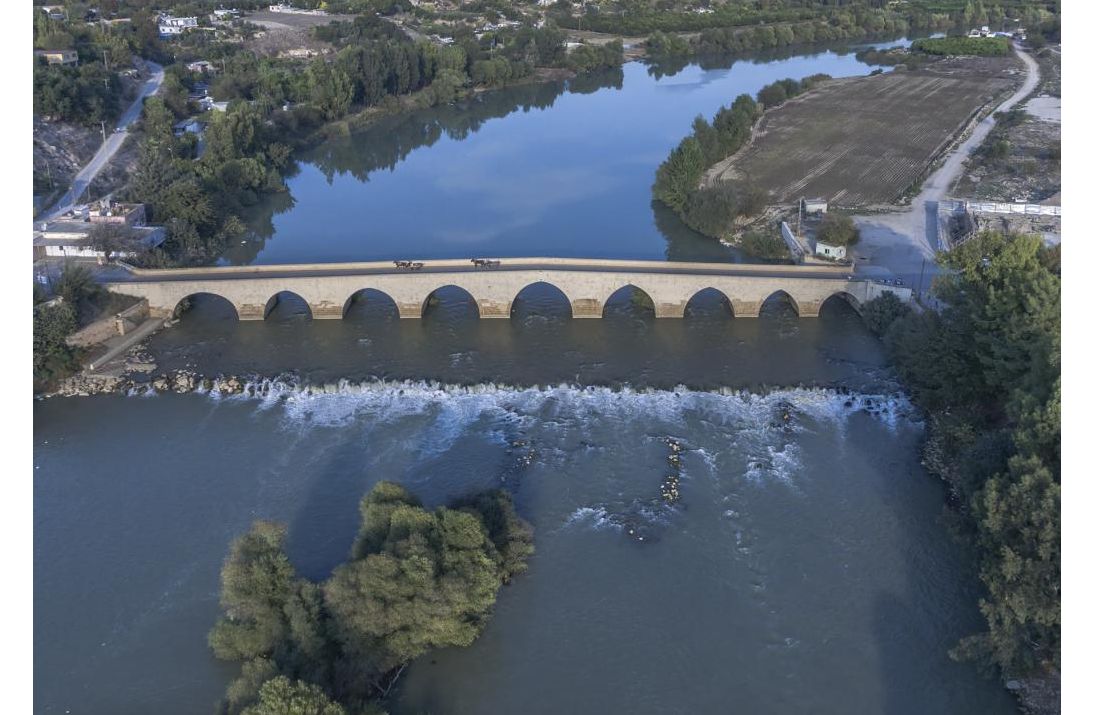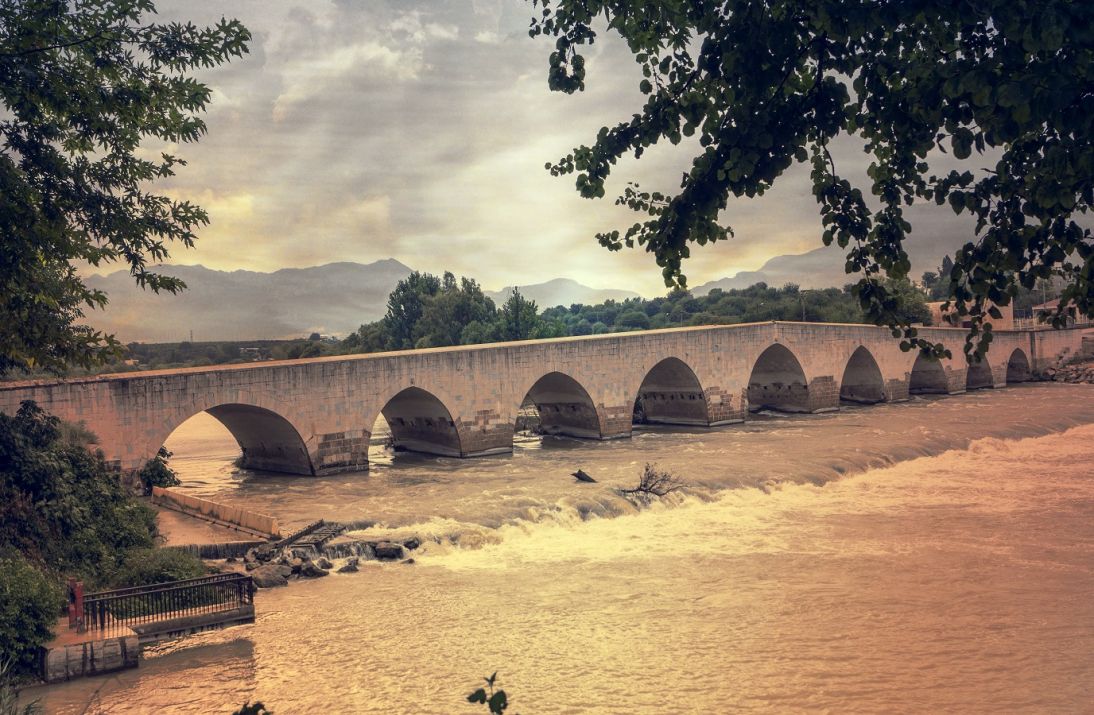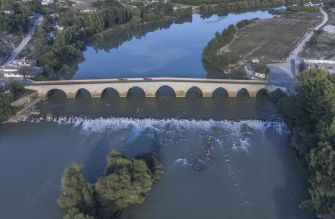Misis Bridge
Adana is the city of bridges. Two of Turkey's 13 most important bridges, announced by the Ministry of Tourism in 2019, are in Adana. Seyhan and Ceyhan Rivers divide the lands from north to south together with their branches. Adding to this that the location of the region on the important roads connecting Anatolia to the Middle East, important bridges were built all over Adana The Romans who built Taşköprü, the symbol of Adana, on the Seyhan River, also built the Misis Bridge on the Ceyhan River.
Traces of settlement dating back to the Neolithic period can be seen in Misis Mound right next to the bridge. In ancient times, the two most important criteria for living spaces were proximity to water and safety. The hills known as Höyük throughout Anatolia provided these requirements. They are also ideal places to be protected from overflowing rivers in winter and spring. While Tepebağ Höyük is the oldest settlement that protect people from the floods of the Seyhan River in Adana, Misis Mound has also been the preferred settlement to be protected from the floods of Ceyhan. It is inevitable to build bridges for transportation in such settlements.
According to some historians, the first construction date of Misis Bridge dates back to 1200 BC. Mopsus, one of the commanders who participated in the Trojan War from Cilicia, returned to Çukurova after the war and built this bridge while establishing the city of Misis, which will be named after him. Just like Taşköprü in the center of Adana, it is thought that the original bridge was built later on the place where an old bridge was located.
Misis Bridge in its current form is the first bridge built by the Romans in Anatolia. 4th century Roman Emperor II. Built by Flavius Julius Costantinus, the bridge was repaired by Emperor Justinian in the middle of the 6th century.
The Ottomans attached great importance to the Misis Bridge as it was on the pilgrimage route and the Aleppo trade route.
When Karahalil, son of Turkmen Bey Ali, rebelled in the vicinity of Payas, he had the middle part of Misis Bridge demolished when he gained power in the region. The purpose of this is that the customs money paid by those who cross the bridge go to the Ottoman state. He passed people who could not pass the collapsed bridge with boats and the income here was left to him. The ruined state of the middle part of the bridge is also reflected in the engraving of the drawing master Murdock, next to the famous English traveler Barlett, who came to Çukurova in the 1830s. The bridge was last restored in 1998.
At the head of the armies of the Ottoman Empire in two Baghdad campaigns, Süleyman the Magnificent and IV. Murat also passed through the Misis Bridge.
The Misis Bridge, which has 9 sections, is 133 meters long and 6.5 meters wide.
Misis Bridge Legend & Story
Misis Bridge is famous for its Lokman Hekim (hekim means phsycian in Turkish) legend. Because of this legend, it is also known as the Bridge of Immortality.
Lokman Hekim is a righteous person whose name is also mentioned in the Qur'an, but it is not certain whether he was a prophet or not. There was no disease that Lokman Hekim can’t cure. He has become very famous in the field of medicine. More precisely, there was only one problem that he could not find a solution to: death.
Over time, he dedicates himself to finding the cure for death. While he was sleeping on the banks of the Ceyhan River, a weed called out to him in his dream: "O Lokman, I have the cure for death," he says the place of the plant, and also describes how to make the medicine. Lokman Hekim, who wakes up immediately, finds the herb next to him and notes the details of drug making in his dream in his notebook. A strong wind blows the grass and the notebook into the Ceyhan River just as it passes the Misis Bridge. Lokman Hekim also jumps into the water, but unfortunately he cannot find the herb or its notes. It is believed that the only page that can be found from his notebook is the source of all medical science today.
In a different version of the story, Allah sends Gabriel and Gabriel hits Lokman Hekim with his wings making the notes and herb fall to Ceyhan River just as he passes the Misis Bridge. After all, death is inevitable. Every soul will taste the death.
Misis Museum (Misis Mosaic)
Misis Museum was a museum where mosaics unearthed from the old Misis Mound were exhibited. With the opening of the New Museum Complex in Adana, all the mosaics in the region were moved from here to the museum. All mosaics in the Çukurova Region are exhibited in the mosaic section of the Adana New Museum Complex.
German Archaeologists Dr. Ludwig Budde and Prof. The animals in Noah's ark are depicted in the mosaic unearthed during excavations by Teheodore Bossert in 1956.
In the middle of the mosaic, there is a coop made in the form of a table, around it 23 birds and poultry that Prophet Noah took to his ark in the flood, and around this group there are wild and domestic animals. Inside the mosaic, there is the inscription "Kibuwtocnweb", which means "related to Noah's Flood" in Latin.
Where is Misis Bridge? Directions Information. How to Get to the Bridge?
Misis Bridge is located in Misis village in Adana's central Yüreğir District. Its distance to Adana is 27 km.
To go from Adana to Misis Bridge by private car, you should proceed east on the Adana-Osmaniye highway, and after passing the Hacı Sabancı Organized Industrial Zone, turn right from the Misis sign.
Municipal buses 581 and 596 can be used to reach Misis Bridge by public transport.
Admission to Misis Bridge is free.
Places to be seen around Misis Bridge:
Yılankale: 19 km
Kurtkulagi Caravanserai: 35 km
Yumurtalik Castles: 37,2 km
Suleyman Tower: 36,5 km





